Organisational Theory and Practice: Case Study of THOMAS COOK
VerifiedAdded on 2023/01/10
|12
|3913
|81
Report
AI Summary
This report provides a comprehensive analysis of organisational theory and practice within THOMAS COOK, focusing on the leadership of CEO Peter Fankhauser. It examines the management styles and principles employed, highlighting the democratic approach and its impact on employee engagement. The report delves into the organisational structure, specifically the matrix structure, and its influence on staff performance and company culture. Furthermore, it analyses Peter Fankhauser's leadership styles, including transformational and participative approaches, and assesses the effects of power, influence, and conflict within the organisation. The report also discusses various motivational theories applied at THOMAS COOK and concludes with recommendations for improvement.
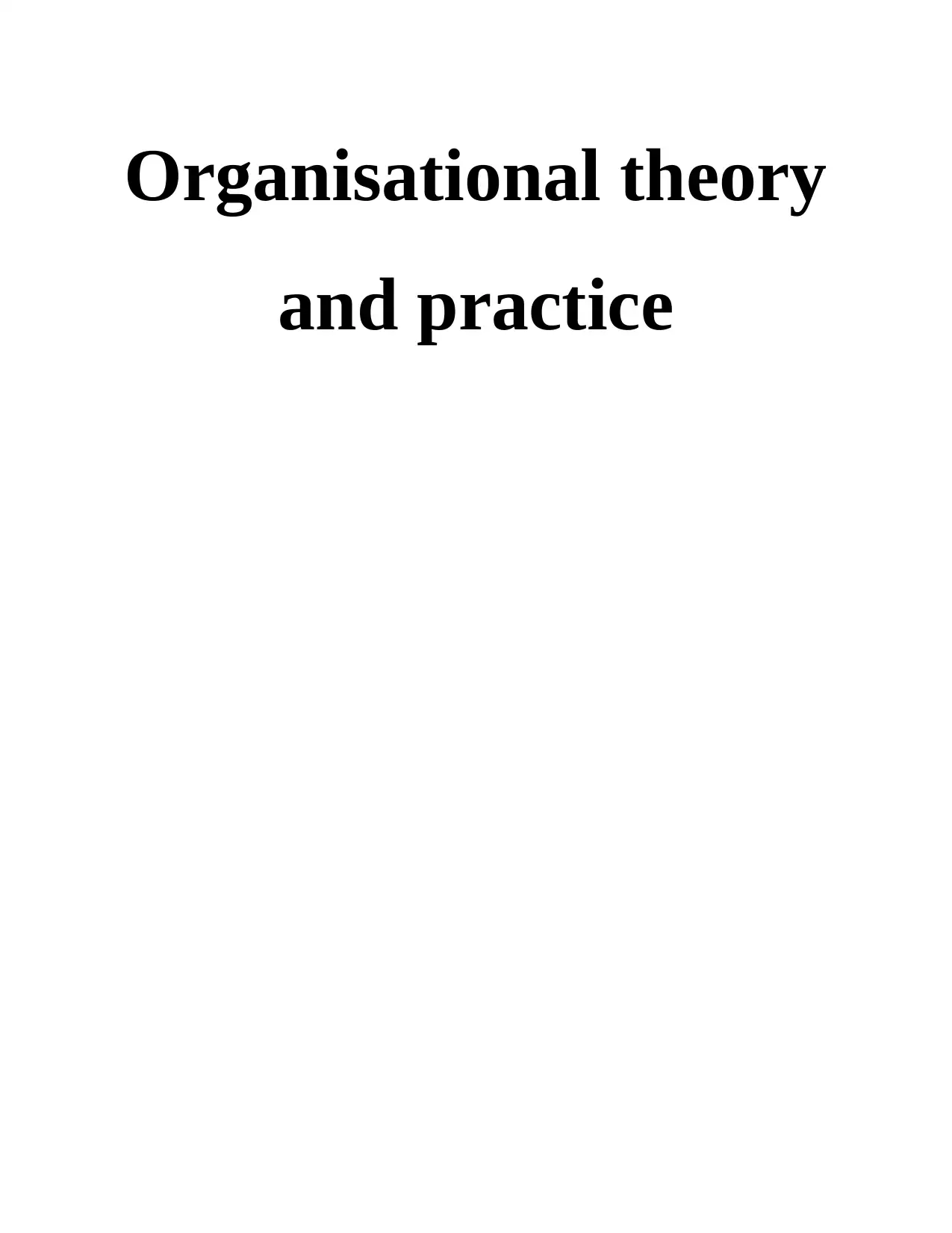
Organisational theory
and practice
and practice
Paraphrase This Document
Need a fresh take? Get an instant paraphrase of this document with our AI Paraphraser
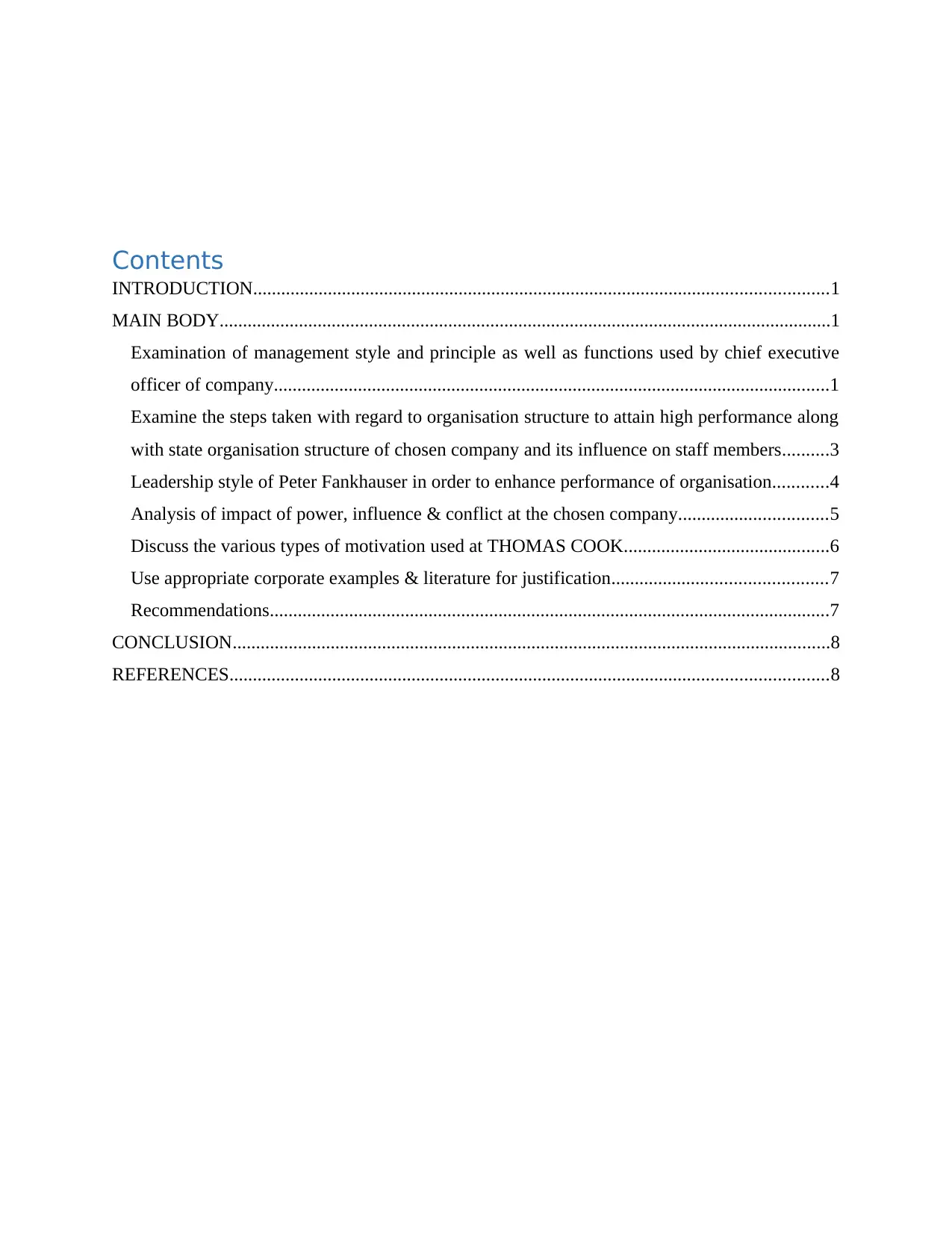
Contents
INTRODUCTION...........................................................................................................................1
MAIN BODY...................................................................................................................................1
Examination of management style and principle as well as functions used by chief executive
officer of company.......................................................................................................................1
Examine the steps taken with regard to organisation structure to attain high performance along
with state organisation structure of chosen company and its influence on staff members..........3
Leadership style of Peter Fankhauser in order to enhance performance of organisation............4
Analysis of impact of power, influence & conflict at the chosen company................................5
Discuss the various types of motivation used at THOMAS COOK............................................6
Use appropriate corporate examples & literature for justification..............................................7
Recommendations........................................................................................................................7
CONCLUSION................................................................................................................................8
REFERENCES................................................................................................................................8
INTRODUCTION...........................................................................................................................1
MAIN BODY...................................................................................................................................1
Examination of management style and principle as well as functions used by chief executive
officer of company.......................................................................................................................1
Examine the steps taken with regard to organisation structure to attain high performance along
with state organisation structure of chosen company and its influence on staff members..........3
Leadership style of Peter Fankhauser in order to enhance performance of organisation............4
Analysis of impact of power, influence & conflict at the chosen company................................5
Discuss the various types of motivation used at THOMAS COOK............................................6
Use appropriate corporate examples & literature for justification..............................................7
Recommendations........................................................................................................................7
CONCLUSION................................................................................................................................8
REFERENCES................................................................................................................................8
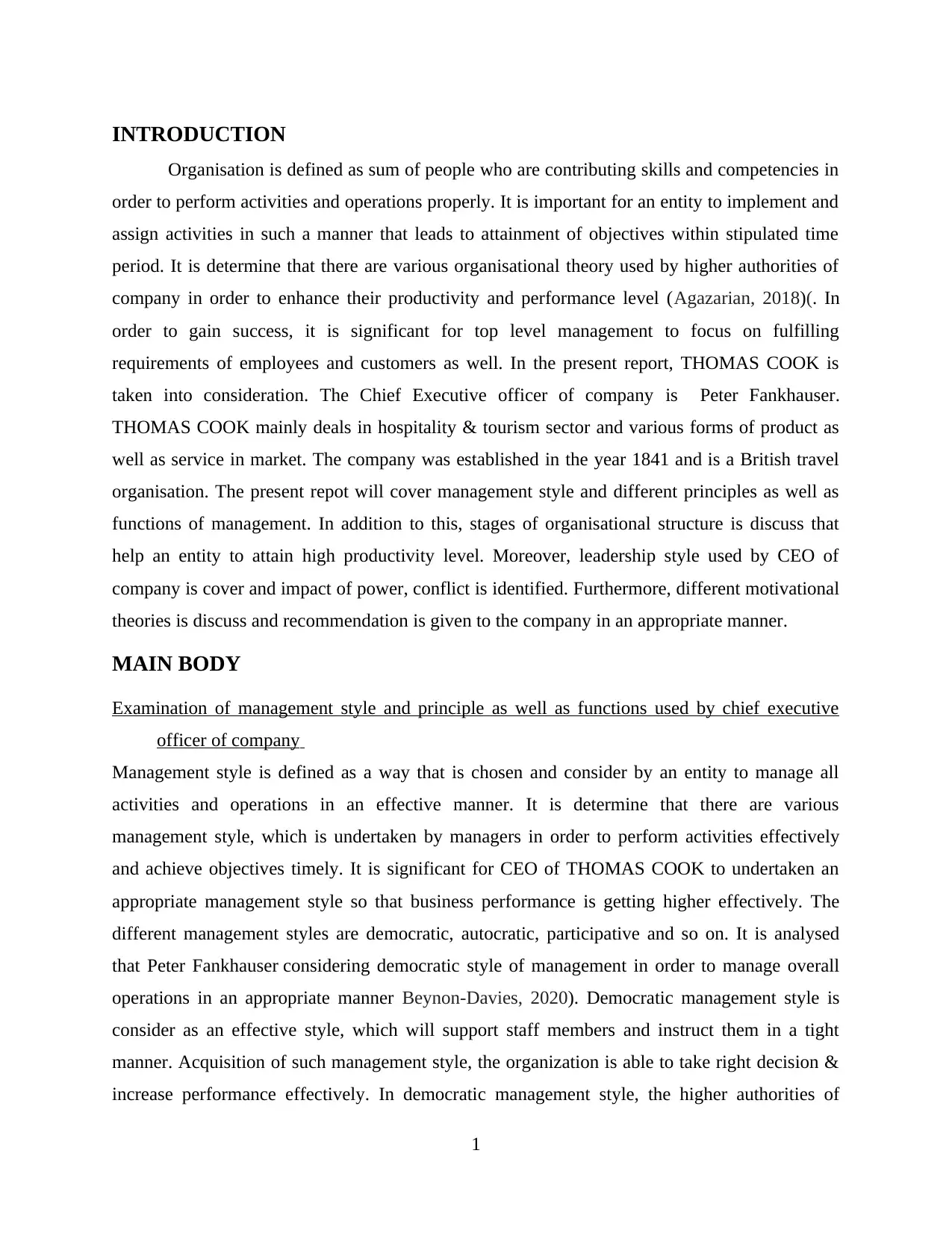
INTRODUCTION
Organisation is defined as sum of people who are contributing skills and competencies in
order to perform activities and operations properly. It is important for an entity to implement and
assign activities in such a manner that leads to attainment of objectives within stipulated time
period. It is determine that there are various organisational theory used by higher authorities of
company in order to enhance their productivity and performance level (Agazarian, 2018)(. In
order to gain success, it is significant for top level management to focus on fulfilling
requirements of employees and customers as well. In the present report, THOMAS COOK is
taken into consideration. The Chief Executive officer of company is Peter Fankhauser.
THOMAS COOK mainly deals in hospitality & tourism sector and various forms of product as
well as service in market. The company was established in the year 1841 and is a British travel
organisation. The present repot will cover management style and different principles as well as
functions of management. In addition to this, stages of organisational structure is discuss that
help an entity to attain high productivity level. Moreover, leadership style used by CEO of
company is cover and impact of power, conflict is identified. Furthermore, different motivational
theories is discuss and recommendation is given to the company in an appropriate manner.
MAIN BODY
Examination of management style and principle as well as functions used by chief executive
officer of company
Management style is defined as a way that is chosen and consider by an entity to manage all
activities and operations in an effective manner. It is determine that there are various
management style, which is undertaken by managers in order to perform activities effectively
and achieve objectives timely. It is significant for CEO of THOMAS COOK to undertaken an
appropriate management style so that business performance is getting higher effectively. The
different management styles are democratic, autocratic, participative and so on. It is analysed
that Peter Fankhauser considering democratic style of management in order to manage overall
operations in an appropriate manner Beynon-Davies, 2020). Democratic management style is
consider as an effective style, which will support staff members and instruct them in a tight
manner. Acquisition of such management style, the organization is able to take right decision &
increase performance effectively. In democratic management style, the higher authorities of
1
Organisation is defined as sum of people who are contributing skills and competencies in
order to perform activities and operations properly. It is important for an entity to implement and
assign activities in such a manner that leads to attainment of objectives within stipulated time
period. It is determine that there are various organisational theory used by higher authorities of
company in order to enhance their productivity and performance level (Agazarian, 2018)(. In
order to gain success, it is significant for top level management to focus on fulfilling
requirements of employees and customers as well. In the present report, THOMAS COOK is
taken into consideration. The Chief Executive officer of company is Peter Fankhauser.
THOMAS COOK mainly deals in hospitality & tourism sector and various forms of product as
well as service in market. The company was established in the year 1841 and is a British travel
organisation. The present repot will cover management style and different principles as well as
functions of management. In addition to this, stages of organisational structure is discuss that
help an entity to attain high productivity level. Moreover, leadership style used by CEO of
company is cover and impact of power, conflict is identified. Furthermore, different motivational
theories is discuss and recommendation is given to the company in an appropriate manner.
MAIN BODY
Examination of management style and principle as well as functions used by chief executive
officer of company
Management style is defined as a way that is chosen and consider by an entity to manage all
activities and operations in an effective manner. It is determine that there are various
management style, which is undertaken by managers in order to perform activities effectively
and achieve objectives timely. It is significant for CEO of THOMAS COOK to undertaken an
appropriate management style so that business performance is getting higher effectively. The
different management styles are democratic, autocratic, participative and so on. It is analysed
that Peter Fankhauser considering democratic style of management in order to manage overall
operations in an appropriate manner Beynon-Davies, 2020). Democratic management style is
consider as an effective style, which will support staff members and instruct them in a tight
manner. Acquisition of such management style, the organization is able to take right decision &
increase performance effectively. In democratic management style, the higher authorities of
1
⊘ This is a preview!⊘
Do you want full access?
Subscribe today to unlock all pages.

Trusted by 1+ million students worldwide
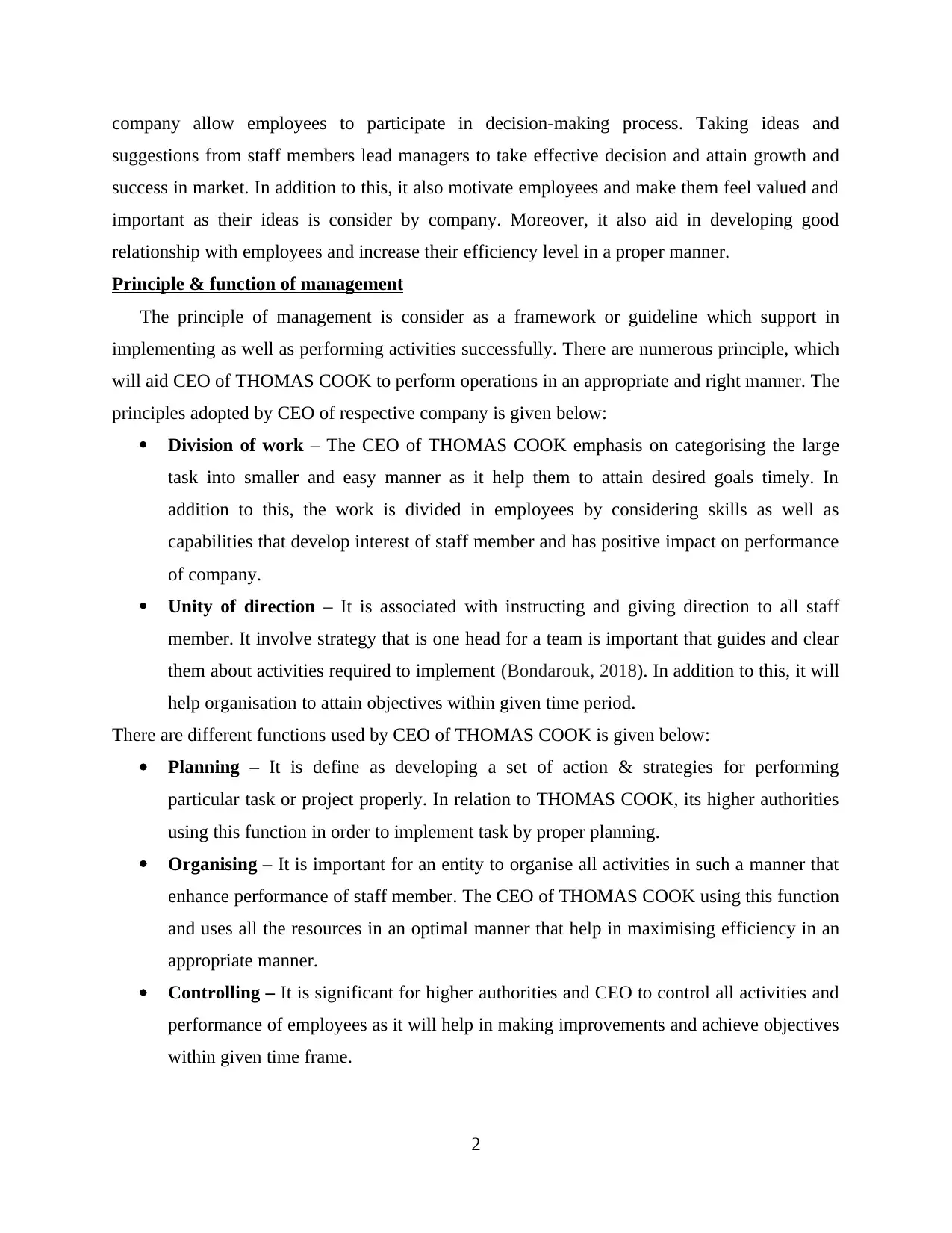
company allow employees to participate in decision-making process. Taking ideas and
suggestions from staff members lead managers to take effective decision and attain growth and
success in market. In addition to this, it also motivate employees and make them feel valued and
important as their ideas is consider by company. Moreover, it also aid in developing good
relationship with employees and increase their efficiency level in a proper manner.
Principle & function of management
The principle of management is consider as a framework or guideline which support in
implementing as well as performing activities successfully. There are numerous principle, which
will aid CEO of THOMAS COOK to perform operations in an appropriate and right manner. The
principles adopted by CEO of respective company is given below:
Division of work – The CEO of THOMAS COOK emphasis on categorising the large
task into smaller and easy manner as it help them to attain desired goals timely. In
addition to this, the work is divided in employees by considering skills as well as
capabilities that develop interest of staff member and has positive impact on performance
of company.
Unity of direction – It is associated with instructing and giving direction to all staff
member. It involve strategy that is one head for a team is important that guides and clear
them about activities required to implement (Bondarouk, 2018). In addition to this, it will
help organisation to attain objectives within given time period.
There are different functions used by CEO of THOMAS COOK is given below:
Planning – It is define as developing a set of action & strategies for performing
particular task or project properly. In relation to THOMAS COOK, its higher authorities
using this function in order to implement task by proper planning.
Organising – It is important for an entity to organise all activities in such a manner that
enhance performance of staff member. The CEO of THOMAS COOK using this function
and uses all the resources in an optimal manner that help in maximising efficiency in an
appropriate manner.
Controlling – It is significant for higher authorities and CEO to control all activities and
performance of employees as it will help in making improvements and achieve objectives
within given time frame.
2
suggestions from staff members lead managers to take effective decision and attain growth and
success in market. In addition to this, it also motivate employees and make them feel valued and
important as their ideas is consider by company. Moreover, it also aid in developing good
relationship with employees and increase their efficiency level in a proper manner.
Principle & function of management
The principle of management is consider as a framework or guideline which support in
implementing as well as performing activities successfully. There are numerous principle, which
will aid CEO of THOMAS COOK to perform operations in an appropriate and right manner. The
principles adopted by CEO of respective company is given below:
Division of work – The CEO of THOMAS COOK emphasis on categorising the large
task into smaller and easy manner as it help them to attain desired goals timely. In
addition to this, the work is divided in employees by considering skills as well as
capabilities that develop interest of staff member and has positive impact on performance
of company.
Unity of direction – It is associated with instructing and giving direction to all staff
member. It involve strategy that is one head for a team is important that guides and clear
them about activities required to implement (Bondarouk, 2018). In addition to this, it will
help organisation to attain objectives within given time period.
There are different functions used by CEO of THOMAS COOK is given below:
Planning – It is define as developing a set of action & strategies for performing
particular task or project properly. In relation to THOMAS COOK, its higher authorities
using this function in order to implement task by proper planning.
Organising – It is important for an entity to organise all activities in such a manner that
enhance performance of staff member. The CEO of THOMAS COOK using this function
and uses all the resources in an optimal manner that help in maximising efficiency in an
appropriate manner.
Controlling – It is significant for higher authorities and CEO to control all activities and
performance of employees as it will help in making improvements and achieve objectives
within given time frame.
2
Paraphrase This Document
Need a fresh take? Get an instant paraphrase of this document with our AI Paraphraser
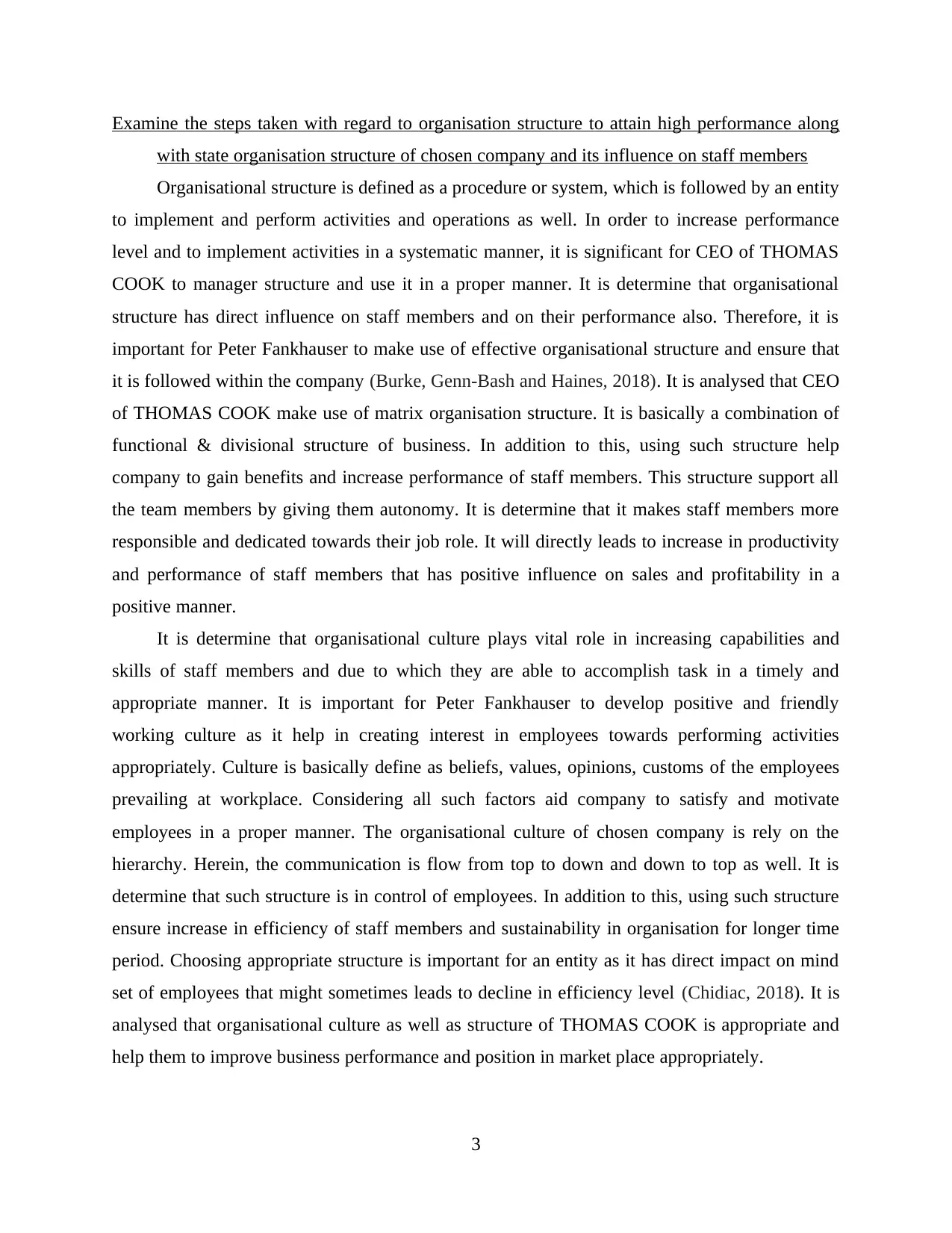
Examine the steps taken with regard to organisation structure to attain high performance along
with state organisation structure of chosen company and its influence on staff members
Organisational structure is defined as a procedure or system, which is followed by an entity
to implement and perform activities and operations as well. In order to increase performance
level and to implement activities in a systematic manner, it is significant for CEO of THOMAS
COOK to manager structure and use it in a proper manner. It is determine that organisational
structure has direct influence on staff members and on their performance also. Therefore, it is
important for Peter Fankhauser to make use of effective organisational structure and ensure that
it is followed within the company (Burke, Genn-Bash and Haines, 2018). It is analysed that CEO
of THOMAS COOK make use of matrix organisation structure. It is basically a combination of
functional & divisional structure of business. In addition to this, using such structure help
company to gain benefits and increase performance of staff members. This structure support all
the team members by giving them autonomy. It is determine that it makes staff members more
responsible and dedicated towards their job role. It will directly leads to increase in productivity
and performance of staff members that has positive influence on sales and profitability in a
positive manner.
It is determine that organisational culture plays vital role in increasing capabilities and
skills of staff members and due to which they are able to accomplish task in a timely and
appropriate manner. It is important for Peter Fankhauser to develop positive and friendly
working culture as it help in creating interest in employees towards performing activities
appropriately. Culture is basically define as beliefs, values, opinions, customs of the employees
prevailing at workplace. Considering all such factors aid company to satisfy and motivate
employees in a proper manner. The organisational culture of chosen company is rely on the
hierarchy. Herein, the communication is flow from top to down and down to top as well. It is
determine that such structure is in control of employees. In addition to this, using such structure
ensure increase in efficiency of staff members and sustainability in organisation for longer time
period. Choosing appropriate structure is important for an entity as it has direct impact on mind
set of employees that might sometimes leads to decline in efficiency level (Chidiac, 2018). It is
analysed that organisational culture as well as structure of THOMAS COOK is appropriate and
help them to improve business performance and position in market place appropriately.
3
with state organisation structure of chosen company and its influence on staff members
Organisational structure is defined as a procedure or system, which is followed by an entity
to implement and perform activities and operations as well. In order to increase performance
level and to implement activities in a systematic manner, it is significant for CEO of THOMAS
COOK to manager structure and use it in a proper manner. It is determine that organisational
structure has direct influence on staff members and on their performance also. Therefore, it is
important for Peter Fankhauser to make use of effective organisational structure and ensure that
it is followed within the company (Burke, Genn-Bash and Haines, 2018). It is analysed that CEO
of THOMAS COOK make use of matrix organisation structure. It is basically a combination of
functional & divisional structure of business. In addition to this, using such structure help
company to gain benefits and increase performance of staff members. This structure support all
the team members by giving them autonomy. It is determine that it makes staff members more
responsible and dedicated towards their job role. It will directly leads to increase in productivity
and performance of staff members that has positive influence on sales and profitability in a
positive manner.
It is determine that organisational culture plays vital role in increasing capabilities and
skills of staff members and due to which they are able to accomplish task in a timely and
appropriate manner. It is important for Peter Fankhauser to develop positive and friendly
working culture as it help in creating interest in employees towards performing activities
appropriately. Culture is basically define as beliefs, values, opinions, customs of the employees
prevailing at workplace. Considering all such factors aid company to satisfy and motivate
employees in a proper manner. The organisational culture of chosen company is rely on the
hierarchy. Herein, the communication is flow from top to down and down to top as well. It is
determine that such structure is in control of employees. In addition to this, using such structure
ensure increase in efficiency of staff members and sustainability in organisation for longer time
period. Choosing appropriate structure is important for an entity as it has direct impact on mind
set of employees that might sometimes leads to decline in efficiency level (Chidiac, 2018). It is
analysed that organisational culture as well as structure of THOMAS COOK is appropriate and
help them to improve business performance and position in market place appropriately.
3
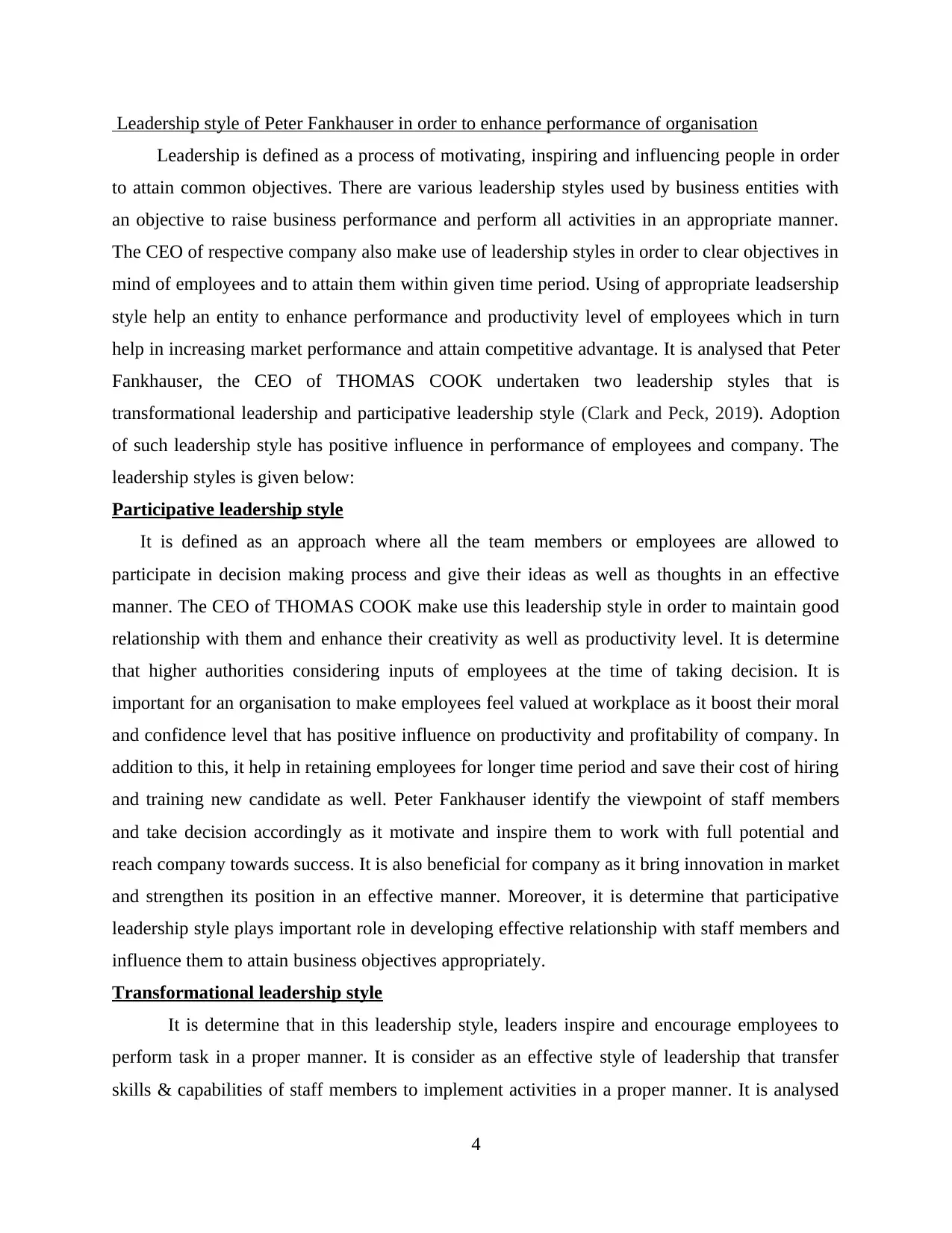
Leadership style of Peter Fankhauser in order to enhance performance of organisation
Leadership is defined as a process of motivating, inspiring and influencing people in order
to attain common objectives. There are various leadership styles used by business entities with
an objective to raise business performance and perform all activities in an appropriate manner.
The CEO of respective company also make use of leadership styles in order to clear objectives in
mind of employees and to attain them within given time period. Using of appropriate leadsership
style help an entity to enhance performance and productivity level of employees which in turn
help in increasing market performance and attain competitive advantage. It is analysed that Peter
Fankhauser, the CEO of THOMAS COOK undertaken two leadership styles that is
transformational leadership and participative leadership style (Clark and Peck, 2019). Adoption
of such leadership style has positive influence in performance of employees and company. The
leadership styles is given below:
Participative leadership style
It is defined as an approach where all the team members or employees are allowed to
participate in decision making process and give their ideas as well as thoughts in an effective
manner. The CEO of THOMAS COOK make use this leadership style in order to maintain good
relationship with them and enhance their creativity as well as productivity level. It is determine
that higher authorities considering inputs of employees at the time of taking decision. It is
important for an organisation to make employees feel valued at workplace as it boost their moral
and confidence level that has positive influence on productivity and profitability of company. In
addition to this, it help in retaining employees for longer time period and save their cost of hiring
and training new candidate as well. Peter Fankhauser identify the viewpoint of staff members
and take decision accordingly as it motivate and inspire them to work with full potential and
reach company towards success. It is also beneficial for company as it bring innovation in market
and strengthen its position in an effective manner. Moreover, it is determine that participative
leadership style plays important role in developing effective relationship with staff members and
influence them to attain business objectives appropriately.
Transformational leadership style
It is determine that in this leadership style, leaders inspire and encourage employees to
perform task in a proper manner. It is consider as an effective style of leadership that transfer
skills & capabilities of staff members to implement activities in a proper manner. It is analysed
4
Leadership is defined as a process of motivating, inspiring and influencing people in order
to attain common objectives. There are various leadership styles used by business entities with
an objective to raise business performance and perform all activities in an appropriate manner.
The CEO of respective company also make use of leadership styles in order to clear objectives in
mind of employees and to attain them within given time period. Using of appropriate leadsership
style help an entity to enhance performance and productivity level of employees which in turn
help in increasing market performance and attain competitive advantage. It is analysed that Peter
Fankhauser, the CEO of THOMAS COOK undertaken two leadership styles that is
transformational leadership and participative leadership style (Clark and Peck, 2019). Adoption
of such leadership style has positive influence in performance of employees and company. The
leadership styles is given below:
Participative leadership style
It is defined as an approach where all the team members or employees are allowed to
participate in decision making process and give their ideas as well as thoughts in an effective
manner. The CEO of THOMAS COOK make use this leadership style in order to maintain good
relationship with them and enhance their creativity as well as productivity level. It is determine
that higher authorities considering inputs of employees at the time of taking decision. It is
important for an organisation to make employees feel valued at workplace as it boost their moral
and confidence level that has positive influence on productivity and profitability of company. In
addition to this, it help in retaining employees for longer time period and save their cost of hiring
and training new candidate as well. Peter Fankhauser identify the viewpoint of staff members
and take decision accordingly as it motivate and inspire them to work with full potential and
reach company towards success. It is also beneficial for company as it bring innovation in market
and strengthen its position in an effective manner. Moreover, it is determine that participative
leadership style plays important role in developing effective relationship with staff members and
influence them to attain business objectives appropriately.
Transformational leadership style
It is determine that in this leadership style, leaders inspire and encourage employees to
perform task in a proper manner. It is consider as an effective style of leadership that transfer
skills & capabilities of staff members to implement activities in a proper manner. It is analysed
4
⊘ This is a preview!⊘
Do you want full access?
Subscribe today to unlock all pages.

Trusted by 1+ million students worldwide
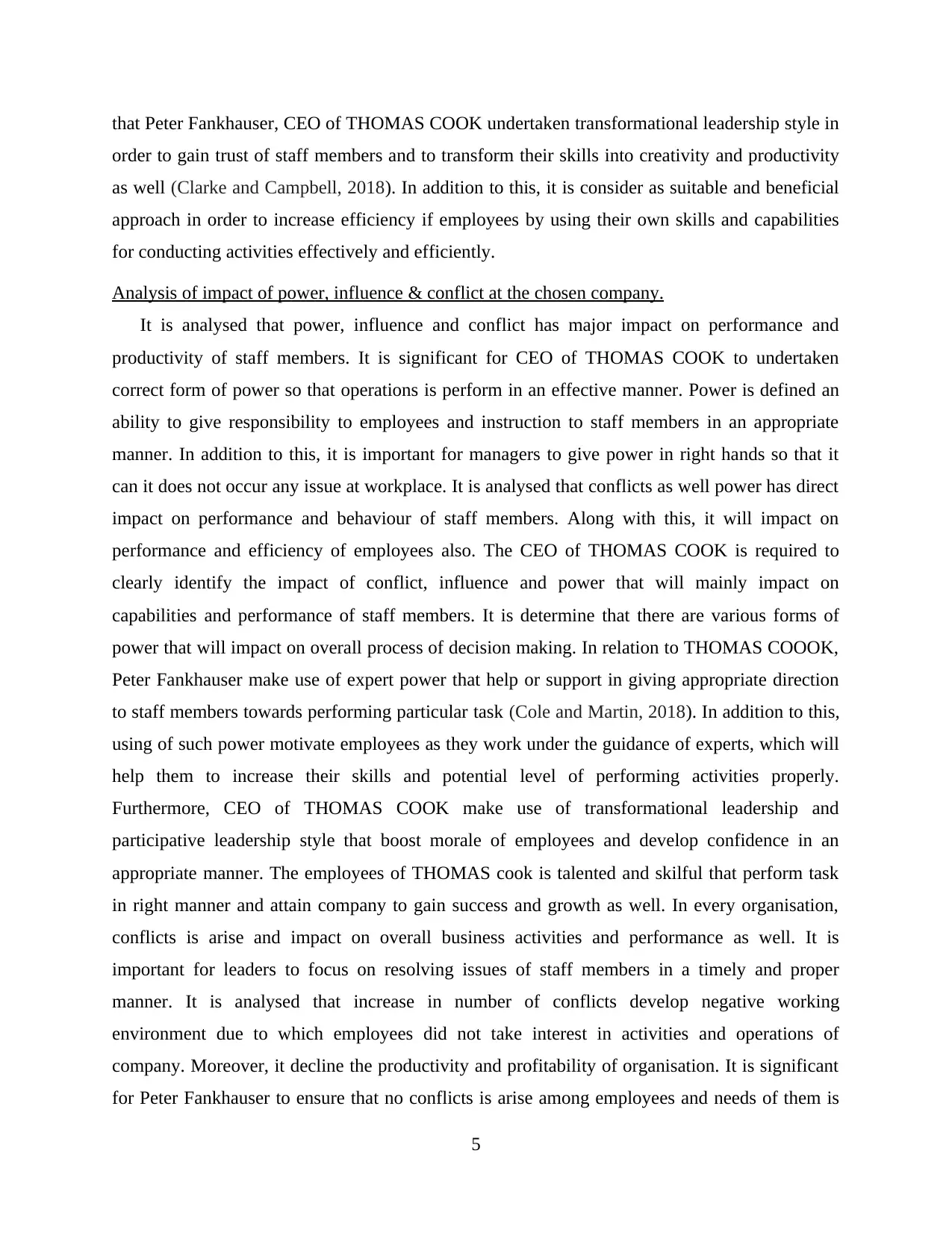
that Peter Fankhauser, CEO of THOMAS COOK undertaken transformational leadership style in
order to gain trust of staff members and to transform their skills into creativity and productivity
as well (Clarke and Campbell, 2018). In addition to this, it is consider as suitable and beneficial
approach in order to increase efficiency if employees by using their own skills and capabilities
for conducting activities effectively and efficiently.
Analysis of impact of power, influence & conflict at the chosen company.
It is analysed that power, influence and conflict has major impact on performance and
productivity of staff members. It is significant for CEO of THOMAS COOK to undertaken
correct form of power so that operations is perform in an effective manner. Power is defined an
ability to give responsibility to employees and instruction to staff members in an appropriate
manner. In addition to this, it is important for managers to give power in right hands so that it
can it does not occur any issue at workplace. It is analysed that conflicts as well power has direct
impact on performance and behaviour of staff members. Along with this, it will impact on
performance and efficiency of employees also. The CEO of THOMAS COOK is required to
clearly identify the impact of conflict, influence and power that will mainly impact on
capabilities and performance of staff members. It is determine that there are various forms of
power that will impact on overall process of decision making. In relation to THOMAS COOOK,
Peter Fankhauser make use of expert power that help or support in giving appropriate direction
to staff members towards performing particular task (Cole and Martin, 2018). In addition to this,
using of such power motivate employees as they work under the guidance of experts, which will
help them to increase their skills and potential level of performing activities properly.
Furthermore, CEO of THOMAS COOK make use of transformational leadership and
participative leadership style that boost morale of employees and develop confidence in an
appropriate manner. The employees of THOMAS cook is talented and skilful that perform task
in right manner and attain company to gain success and growth as well. In every organisation,
conflicts is arise and impact on overall business activities and performance as well. It is
important for leaders to focus on resolving issues of staff members in a timely and proper
manner. It is analysed that increase in number of conflicts develop negative working
environment due to which employees did not take interest in activities and operations of
company. Moreover, it decline the productivity and profitability of organisation. It is significant
for Peter Fankhauser to ensure that no conflicts is arise among employees and needs of them is
5
order to gain trust of staff members and to transform their skills into creativity and productivity
as well (Clarke and Campbell, 2018). In addition to this, it is consider as suitable and beneficial
approach in order to increase efficiency if employees by using their own skills and capabilities
for conducting activities effectively and efficiently.
Analysis of impact of power, influence & conflict at the chosen company.
It is analysed that power, influence and conflict has major impact on performance and
productivity of staff members. It is significant for CEO of THOMAS COOK to undertaken
correct form of power so that operations is perform in an effective manner. Power is defined an
ability to give responsibility to employees and instruction to staff members in an appropriate
manner. In addition to this, it is important for managers to give power in right hands so that it
can it does not occur any issue at workplace. It is analysed that conflicts as well power has direct
impact on performance and behaviour of staff members. Along with this, it will impact on
performance and efficiency of employees also. The CEO of THOMAS COOK is required to
clearly identify the impact of conflict, influence and power that will mainly impact on
capabilities and performance of staff members. It is determine that there are various forms of
power that will impact on overall process of decision making. In relation to THOMAS COOOK,
Peter Fankhauser make use of expert power that help or support in giving appropriate direction
to staff members towards performing particular task (Cole and Martin, 2018). In addition to this,
using of such power motivate employees as they work under the guidance of experts, which will
help them to increase their skills and potential level of performing activities properly.
Furthermore, CEO of THOMAS COOK make use of transformational leadership and
participative leadership style that boost morale of employees and develop confidence in an
appropriate manner. The employees of THOMAS cook is talented and skilful that perform task
in right manner and attain company to gain success and growth as well. In every organisation,
conflicts is arise and impact on overall business activities and performance as well. It is
important for leaders to focus on resolving issues of staff members in a timely and proper
manner. It is analysed that increase in number of conflicts develop negative working
environment due to which employees did not take interest in activities and operations of
company. Moreover, it decline the productivity and profitability of organisation. It is significant
for Peter Fankhauser to ensure that no conflicts is arise among employees and needs of them is
5
Paraphrase This Document
Need a fresh take? Get an instant paraphrase of this document with our AI Paraphraser
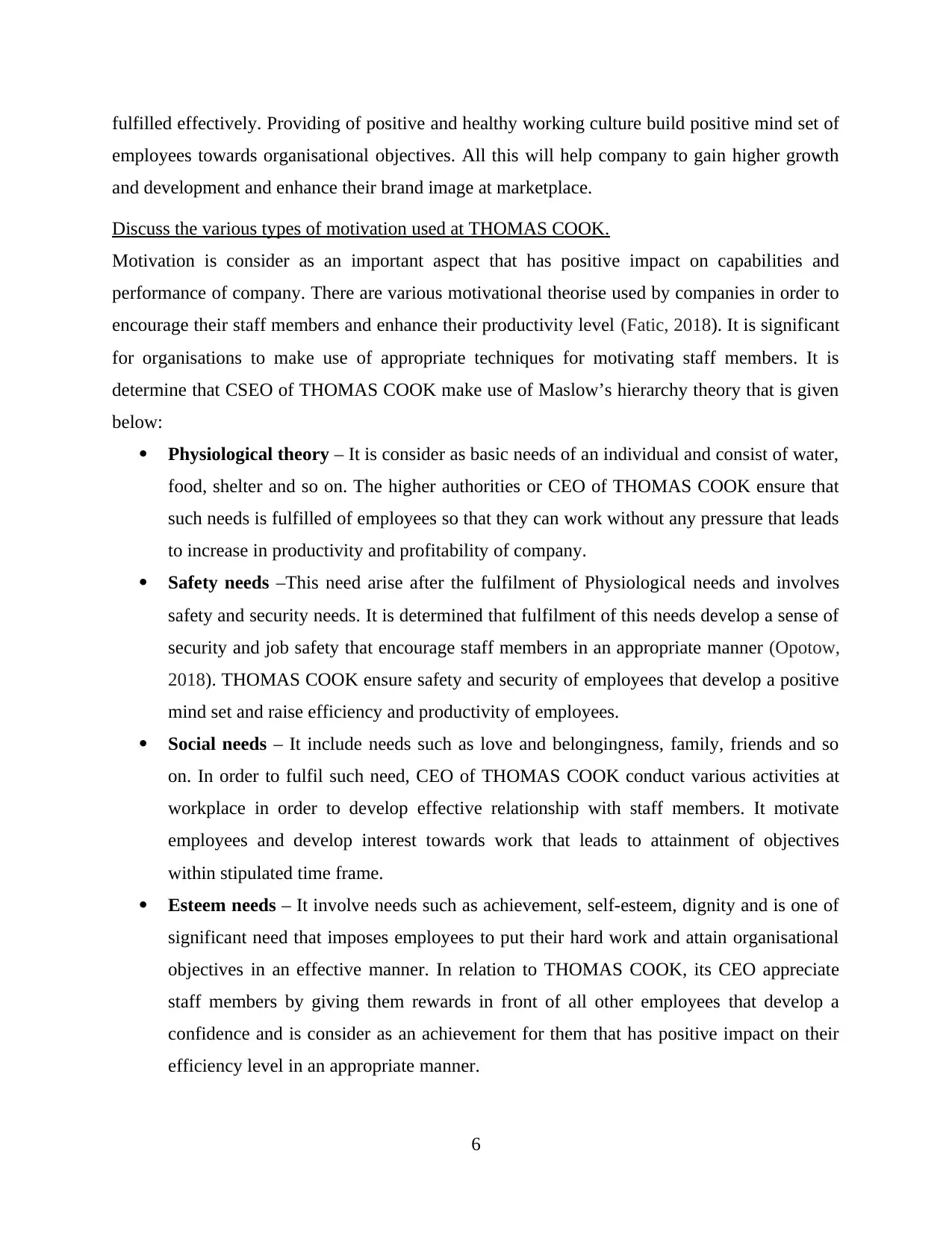
fulfilled effectively. Providing of positive and healthy working culture build positive mind set of
employees towards organisational objectives. All this will help company to gain higher growth
and development and enhance their brand image at marketplace.
Discuss the various types of motivation used at THOMAS COOK.
Motivation is consider as an important aspect that has positive impact on capabilities and
performance of company. There are various motivational theorise used by companies in order to
encourage their staff members and enhance their productivity level (Fatic, 2018). It is significant
for organisations to make use of appropriate techniques for motivating staff members. It is
determine that CSEO of THOMAS COOK make use of Maslow’s hierarchy theory that is given
below:
Physiological theory – It is consider as basic needs of an individual and consist of water,
food, shelter and so on. The higher authorities or CEO of THOMAS COOK ensure that
such needs is fulfilled of employees so that they can work without any pressure that leads
to increase in productivity and profitability of company.
Safety needs –This need arise after the fulfilment of Physiological needs and involves
safety and security needs. It is determined that fulfilment of this needs develop a sense of
security and job safety that encourage staff members in an appropriate manner (Opotow,
2018). THOMAS COOK ensure safety and security of employees that develop a positive
mind set and raise efficiency and productivity of employees.
Social needs – It include needs such as love and belongingness, family, friends and so
on. In order to fulfil such need, CEO of THOMAS COOK conduct various activities at
workplace in order to develop effective relationship with staff members. It motivate
employees and develop interest towards work that leads to attainment of objectives
within stipulated time frame.
Esteem needs – It involve needs such as achievement, self-esteem, dignity and is one of
significant need that imposes employees to put their hard work and attain organisational
objectives in an effective manner. In relation to THOMAS COOK, its CEO appreciate
staff members by giving them rewards in front of all other employees that develop a
confidence and is consider as an achievement for them that has positive impact on their
efficiency level in an appropriate manner.
6
employees towards organisational objectives. All this will help company to gain higher growth
and development and enhance their brand image at marketplace.
Discuss the various types of motivation used at THOMAS COOK.
Motivation is consider as an important aspect that has positive impact on capabilities and
performance of company. There are various motivational theorise used by companies in order to
encourage their staff members and enhance their productivity level (Fatic, 2018). It is significant
for organisations to make use of appropriate techniques for motivating staff members. It is
determine that CSEO of THOMAS COOK make use of Maslow’s hierarchy theory that is given
below:
Physiological theory – It is consider as basic needs of an individual and consist of water,
food, shelter and so on. The higher authorities or CEO of THOMAS COOK ensure that
such needs is fulfilled of employees so that they can work without any pressure that leads
to increase in productivity and profitability of company.
Safety needs –This need arise after the fulfilment of Physiological needs and involves
safety and security needs. It is determined that fulfilment of this needs develop a sense of
security and job safety that encourage staff members in an appropriate manner (Opotow,
2018). THOMAS COOK ensure safety and security of employees that develop a positive
mind set and raise efficiency and productivity of employees.
Social needs – It include needs such as love and belongingness, family, friends and so
on. In order to fulfil such need, CEO of THOMAS COOK conduct various activities at
workplace in order to develop effective relationship with staff members. It motivate
employees and develop interest towards work that leads to attainment of objectives
within stipulated time frame.
Esteem needs – It involve needs such as achievement, self-esteem, dignity and is one of
significant need that imposes employees to put their hard work and attain organisational
objectives in an effective manner. In relation to THOMAS COOK, its CEO appreciate
staff members by giving them rewards in front of all other employees that develop a
confidence and is consider as an achievement for them that has positive impact on their
efficiency level in an appropriate manner.
6
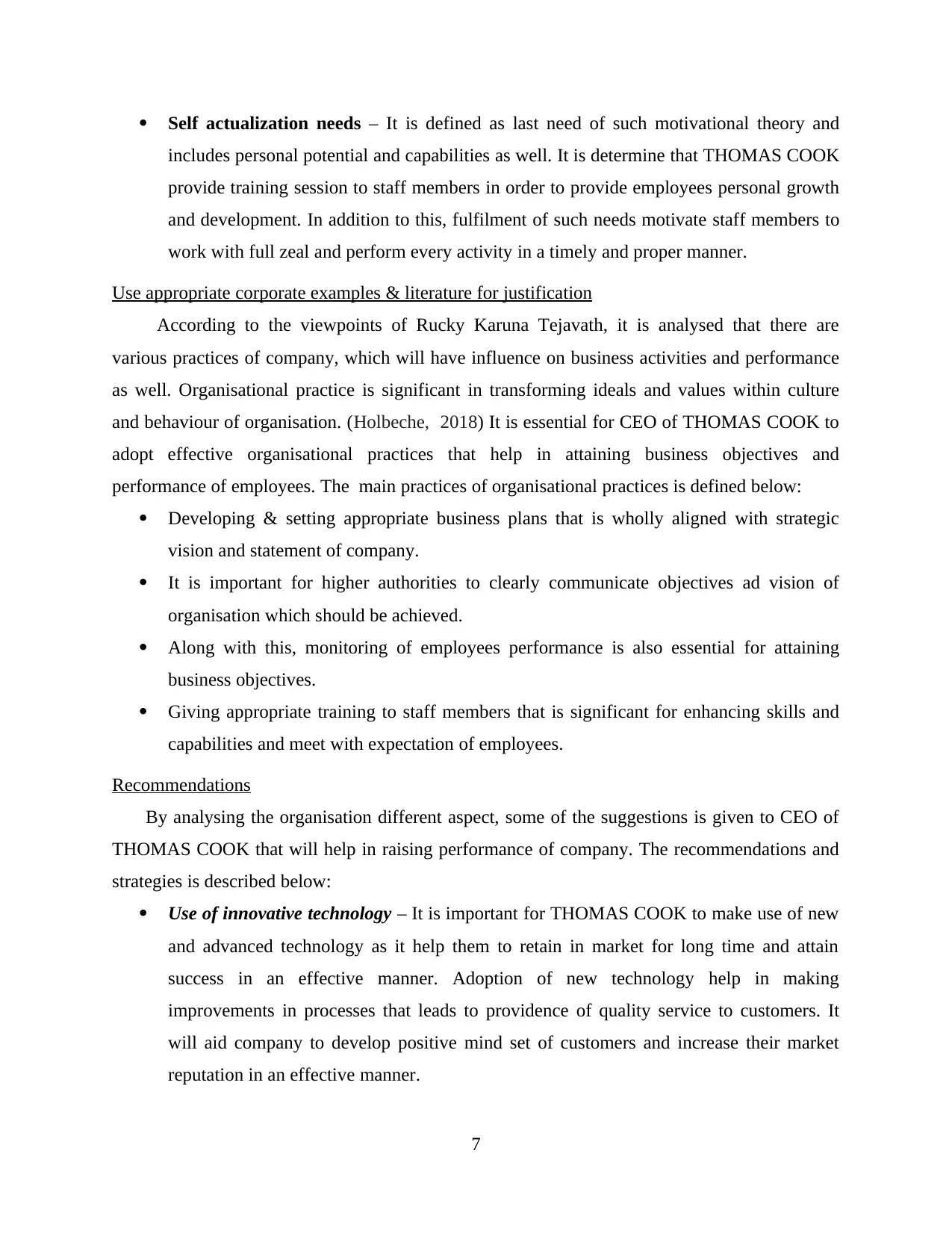
Self actualization needs – It is defined as last need of such motivational theory and
includes personal potential and capabilities as well. It is determine that THOMAS COOK
provide training session to staff members in order to provide employees personal growth
and development. In addition to this, fulfilment of such needs motivate staff members to
work with full zeal and perform every activity in a timely and proper manner.
Use appropriate corporate examples & literature for justification
According to the viewpoints of Rucky Karuna Tejavath, it is analysed that there are
various practices of company, which will have influence on business activities and performance
as well. Organisational practice is significant in transforming ideals and values within culture
and behaviour of organisation. (Holbeche, 2018) It is essential for CEO of THOMAS COOK to
adopt effective organisational practices that help in attaining business objectives and
performance of employees. The main practices of organisational practices is defined below:
Developing & setting appropriate business plans that is wholly aligned with strategic
vision and statement of company.
It is important for higher authorities to clearly communicate objectives ad vision of
organisation which should be achieved.
Along with this, monitoring of employees performance is also essential for attaining
business objectives.
Giving appropriate training to staff members that is significant for enhancing skills and
capabilities and meet with expectation of employees.
Recommendations
By analysing the organisation different aspect, some of the suggestions is given to CEO of
THOMAS COOK that will help in raising performance of company. The recommendations and
strategies is described below:
Use of innovative technology – It is important for THOMAS COOK to make use of new
and advanced technology as it help them to retain in market for long time and attain
success in an effective manner. Adoption of new technology help in making
improvements in processes that leads to providence of quality service to customers. It
will aid company to develop positive mind set of customers and increase their market
reputation in an effective manner.
7
includes personal potential and capabilities as well. It is determine that THOMAS COOK
provide training session to staff members in order to provide employees personal growth
and development. In addition to this, fulfilment of such needs motivate staff members to
work with full zeal and perform every activity in a timely and proper manner.
Use appropriate corporate examples & literature for justification
According to the viewpoints of Rucky Karuna Tejavath, it is analysed that there are
various practices of company, which will have influence on business activities and performance
as well. Organisational practice is significant in transforming ideals and values within culture
and behaviour of organisation. (Holbeche, 2018) It is essential for CEO of THOMAS COOK to
adopt effective organisational practices that help in attaining business objectives and
performance of employees. The main practices of organisational practices is defined below:
Developing & setting appropriate business plans that is wholly aligned with strategic
vision and statement of company.
It is important for higher authorities to clearly communicate objectives ad vision of
organisation which should be achieved.
Along with this, monitoring of employees performance is also essential for attaining
business objectives.
Giving appropriate training to staff members that is significant for enhancing skills and
capabilities and meet with expectation of employees.
Recommendations
By analysing the organisation different aspect, some of the suggestions is given to CEO of
THOMAS COOK that will help in raising performance of company. The recommendations and
strategies is described below:
Use of innovative technology – It is important for THOMAS COOK to make use of new
and advanced technology as it help them to retain in market for long time and attain
success in an effective manner. Adoption of new technology help in making
improvements in processes that leads to providence of quality service to customers. It
will aid company to develop positive mind set of customers and increase their market
reputation in an effective manner.
7
⊘ This is a preview!⊘
Do you want full access?
Subscribe today to unlock all pages.

Trusted by 1+ million students worldwide
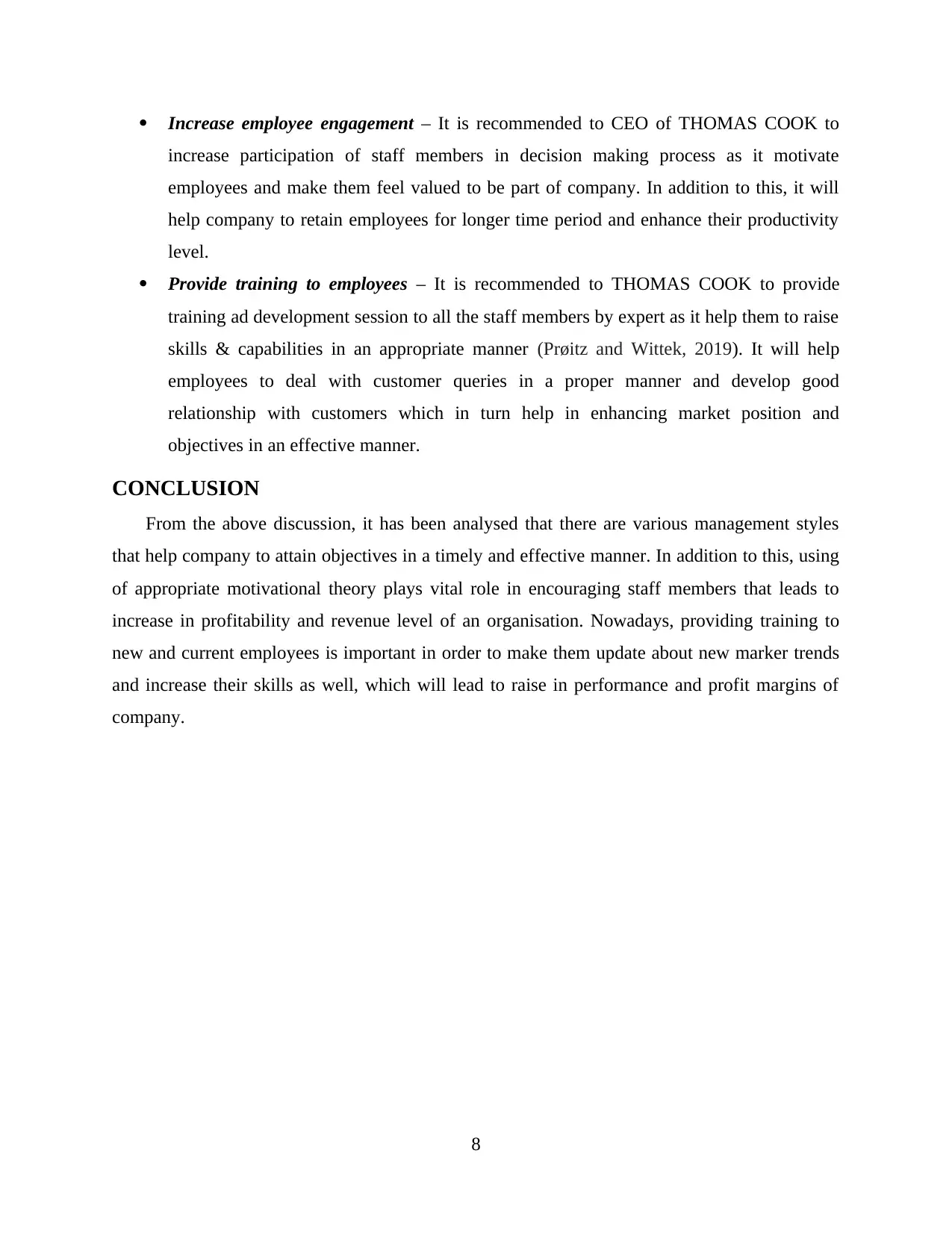
Increase employee engagement – It is recommended to CEO of THOMAS COOK to
increase participation of staff members in decision making process as it motivate
employees and make them feel valued to be part of company. In addition to this, it will
help company to retain employees for longer time period and enhance their productivity
level.
Provide training to employees – It is recommended to THOMAS COOK to provide
training ad development session to all the staff members by expert as it help them to raise
skills & capabilities in an appropriate manner (Prøitz and Wittek, 2019). It will help
employees to deal with customer queries in a proper manner and develop good
relationship with customers which in turn help in enhancing market position and
objectives in an effective manner.
CONCLUSION
From the above discussion, it has been analysed that there are various management styles
that help company to attain objectives in a timely and effective manner. In addition to this, using
of appropriate motivational theory plays vital role in encouraging staff members that leads to
increase in profitability and revenue level of an organisation. Nowadays, providing training to
new and current employees is important in order to make them update about new marker trends
and increase their skills as well, which will lead to raise in performance and profit margins of
company.
8
increase participation of staff members in decision making process as it motivate
employees and make them feel valued to be part of company. In addition to this, it will
help company to retain employees for longer time period and enhance their productivity
level.
Provide training to employees – It is recommended to THOMAS COOK to provide
training ad development session to all the staff members by expert as it help them to raise
skills & capabilities in an appropriate manner (Prøitz and Wittek, 2019). It will help
employees to deal with customer queries in a proper manner and develop good
relationship with customers which in turn help in enhancing market position and
objectives in an effective manner.
CONCLUSION
From the above discussion, it has been analysed that there are various management styles
that help company to attain objectives in a timely and effective manner. In addition to this, using
of appropriate motivational theory plays vital role in encouraging staff members that leads to
increase in profitability and revenue level of an organisation. Nowadays, providing training to
new and current employees is important in order to make them update about new marker trends
and increase their skills as well, which will lead to raise in performance and profit margins of
company.
8
Paraphrase This Document
Need a fresh take? Get an instant paraphrase of this document with our AI Paraphraser
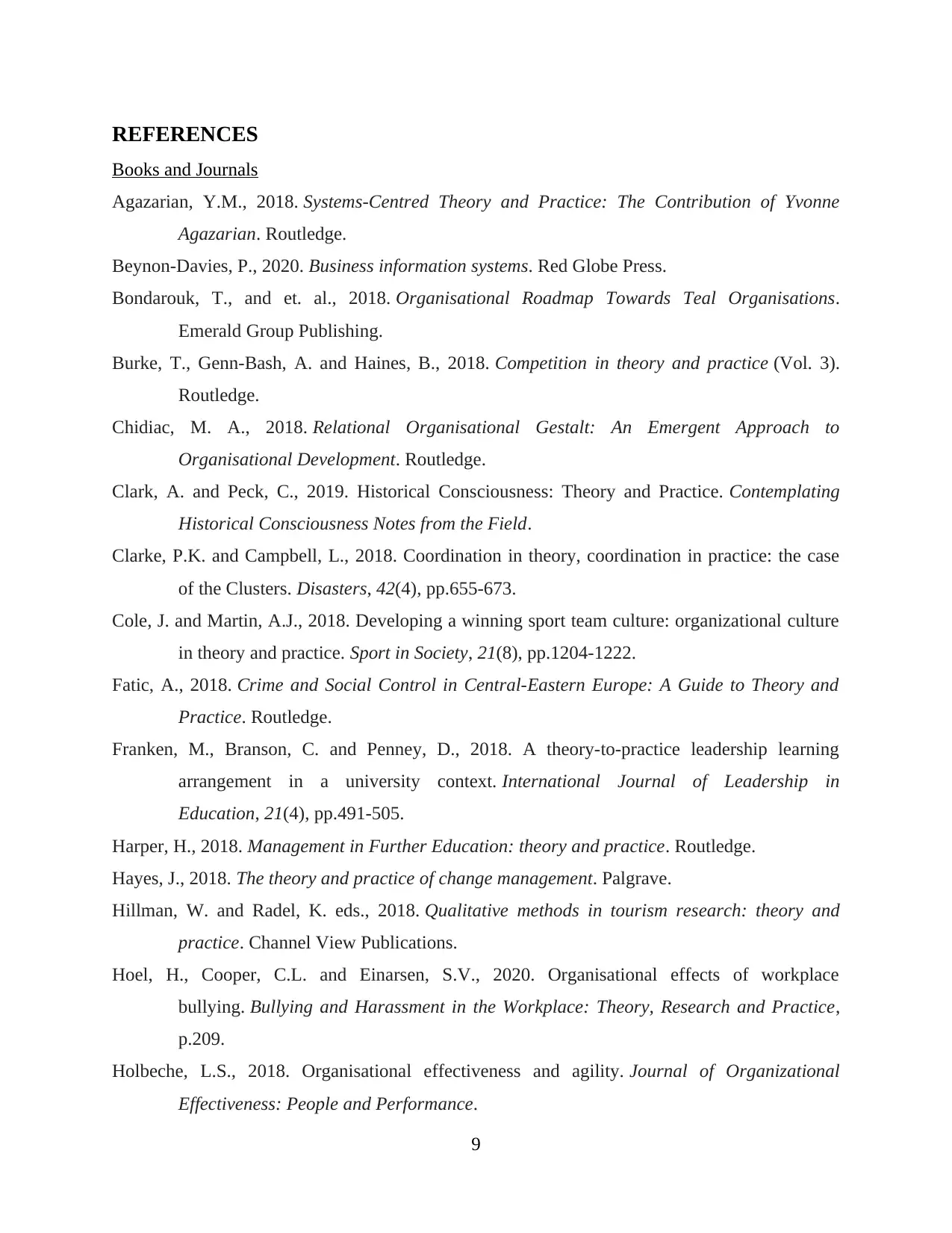
REFERENCES
Books and Journals
Agazarian, Y.M., 2018. Systems-Centred Theory and Practice: The Contribution of Yvonne
Agazarian. Routledge.
Beynon-Davies, P., 2020. Business information systems. Red Globe Press.
Bondarouk, T., and et. al., 2018. Organisational Roadmap Towards Teal Organisations.
Emerald Group Publishing.
Burke, T., Genn-Bash, A. and Haines, B., 2018. Competition in theory and practice (Vol. 3).
Routledge.
Chidiac, M. A., 2018. Relational Organisational Gestalt: An Emergent Approach to
Organisational Development. Routledge.
Clark, A. and Peck, C., 2019. Historical Consciousness: Theory and Practice. Contemplating
Historical Consciousness Notes from the Field.
Clarke, P.K. and Campbell, L., 2018. Coordination in theory, coordination in practice: the case
of the Clusters. Disasters, 42(4), pp.655-673.
Cole, J. and Martin, A.J., 2018. Developing a winning sport team culture: organizational culture
in theory and practice. Sport in Society, 21(8), pp.1204-1222.
Fatic, A., 2018. Crime and Social Control in Central-Eastern Europe: A Guide to Theory and
Practice. Routledge.
Franken, M., Branson, C. and Penney, D., 2018. A theory-to-practice leadership learning
arrangement in a university context. International Journal of Leadership in
Education, 21(4), pp.491-505.
Harper, H., 2018. Management in Further Education: theory and practice. Routledge.
Hayes, J., 2018. The theory and practice of change management. Palgrave.
Hillman, W. and Radel, K. eds., 2018. Qualitative methods in tourism research: theory and
practice. Channel View Publications.
Hoel, H., Cooper, C.L. and Einarsen, S.V., 2020. Organisational effects of workplace
bullying. Bullying and Harassment in the Workplace: Theory, Research and Practice,
p.209.
Holbeche, L.S., 2018. Organisational effectiveness and agility. Journal of Organizational
Effectiveness: People and Performance.
9
Books and Journals
Agazarian, Y.M., 2018. Systems-Centred Theory and Practice: The Contribution of Yvonne
Agazarian. Routledge.
Beynon-Davies, P., 2020. Business information systems. Red Globe Press.
Bondarouk, T., and et. al., 2018. Organisational Roadmap Towards Teal Organisations.
Emerald Group Publishing.
Burke, T., Genn-Bash, A. and Haines, B., 2018. Competition in theory and practice (Vol. 3).
Routledge.
Chidiac, M. A., 2018. Relational Organisational Gestalt: An Emergent Approach to
Organisational Development. Routledge.
Clark, A. and Peck, C., 2019. Historical Consciousness: Theory and Practice. Contemplating
Historical Consciousness Notes from the Field.
Clarke, P.K. and Campbell, L., 2018. Coordination in theory, coordination in practice: the case
of the Clusters. Disasters, 42(4), pp.655-673.
Cole, J. and Martin, A.J., 2018. Developing a winning sport team culture: organizational culture
in theory and practice. Sport in Society, 21(8), pp.1204-1222.
Fatic, A., 2018. Crime and Social Control in Central-Eastern Europe: A Guide to Theory and
Practice. Routledge.
Franken, M., Branson, C. and Penney, D., 2018. A theory-to-practice leadership learning
arrangement in a university context. International Journal of Leadership in
Education, 21(4), pp.491-505.
Harper, H., 2018. Management in Further Education: theory and practice. Routledge.
Hayes, J., 2018. The theory and practice of change management. Palgrave.
Hillman, W. and Radel, K. eds., 2018. Qualitative methods in tourism research: theory and
practice. Channel View Publications.
Hoel, H., Cooper, C.L. and Einarsen, S.V., 2020. Organisational effects of workplace
bullying. Bullying and Harassment in the Workplace: Theory, Research and Practice,
p.209.
Holbeche, L.S., 2018. Organisational effectiveness and agility. Journal of Organizational
Effectiveness: People and Performance.
9
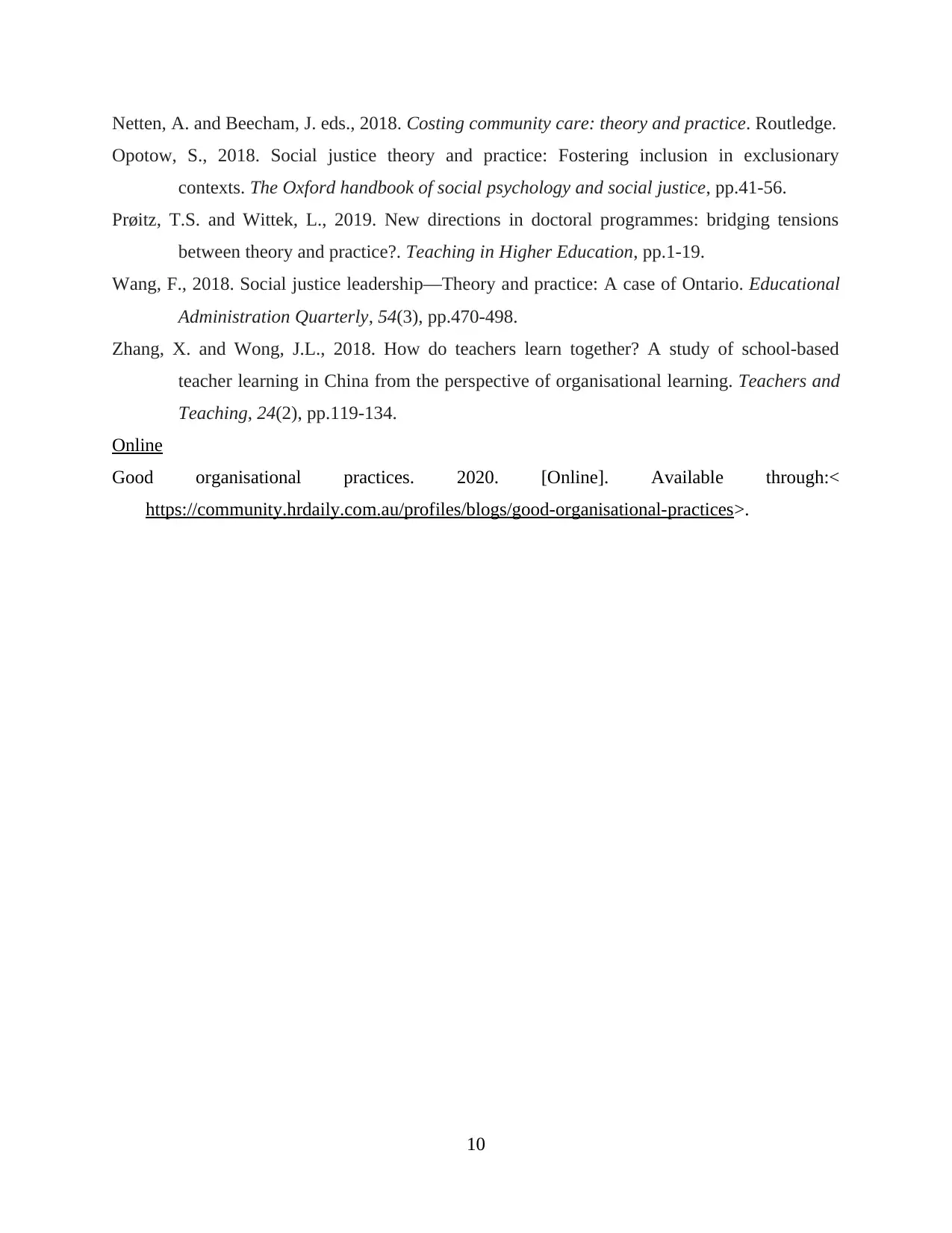
Netten, A. and Beecham, J. eds., 2018. Costing community care: theory and practice. Routledge.
Opotow, S., 2018. Social justice theory and practice: Fostering inclusion in exclusionary
contexts. The Oxford handbook of social psychology and social justice, pp.41-56.
Prøitz, T.S. and Wittek, L., 2019. New directions in doctoral programmes: bridging tensions
between theory and practice?. Teaching in Higher Education, pp.1-19.
Wang, F., 2018. Social justice leadership—Theory and practice: A case of Ontario. Educational
Administration Quarterly, 54(3), pp.470-498.
Zhang, X. and Wong, J.L., 2018. How do teachers learn together? A study of school-based
teacher learning in China from the perspective of organisational learning. Teachers and
Teaching, 24(2), pp.119-134.
Online
Good organisational practices. 2020. [Online]. Available through:<
https://community.hrdaily.com.au/profiles/blogs/good-organisational-practices>.
10
Opotow, S., 2018. Social justice theory and practice: Fostering inclusion in exclusionary
contexts. The Oxford handbook of social psychology and social justice, pp.41-56.
Prøitz, T.S. and Wittek, L., 2019. New directions in doctoral programmes: bridging tensions
between theory and practice?. Teaching in Higher Education, pp.1-19.
Wang, F., 2018. Social justice leadership—Theory and practice: A case of Ontario. Educational
Administration Quarterly, 54(3), pp.470-498.
Zhang, X. and Wong, J.L., 2018. How do teachers learn together? A study of school-based
teacher learning in China from the perspective of organisational learning. Teachers and
Teaching, 24(2), pp.119-134.
Online
Good organisational practices. 2020. [Online]. Available through:<
https://community.hrdaily.com.au/profiles/blogs/good-organisational-practices>.
10
⊘ This is a preview!⊘
Do you want full access?
Subscribe today to unlock all pages.

Trusted by 1+ million students worldwide
1 out of 12
Related Documents
Your All-in-One AI-Powered Toolkit for Academic Success.
+13062052269
info@desklib.com
Available 24*7 on WhatsApp / Email
![[object Object]](/_next/static/media/star-bottom.7253800d.svg)
Unlock your academic potential
Copyright © 2020–2025 A2Z Services. All Rights Reserved. Developed and managed by ZUCOL.





